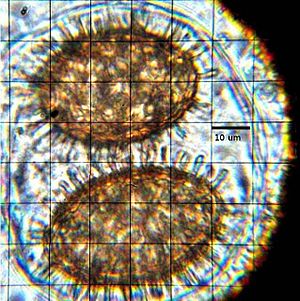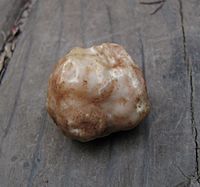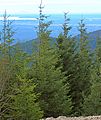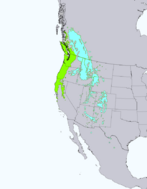Oregon white truffle facts for kids
Quick facts for kids Oregon white truffle |
|
|---|---|
 |
|
| Scientific classification | |
| Genus: |
Tuber
|
| Species: |
oregonense
|
| Tuber oregonense | |
|---|---|
| Mycological characteristics | |
| glebal hymenium | |
| hymenium attachment is not applicable | |
| lacks a stipe | |
| spore print is blackish-brown to brown | |
| ecology is mycorrhizal | |
| edibility: choice | |
Tuber oregonense, often called the Oregon white truffle, is a type of edible truffle. It belongs to the Tuber family. This truffle was first officially described in 2010.
You can find this North American species along the western coast of the United States. It grows from northern California up to southern British Columbia, west of the Cascade Range. The Oregon white truffle is a mycorrhizal fungus. This means it grows in a helpful partnership with Douglas fir trees.
It shares its home with a close relative, T. gibbosum. However, they grow at different times of the year. T. oregonense usually appears from October to March. T. gibbosum grows from January to June. The truffle's fruit bodies look like small potatoes. They can be round or irregular in shape, up to 5 cm (2 in) across. Inside, the truffle has a marbled, tan colored gleba. This truffle is highly valued for its amazing taste and smell. Some people have even tried growing them on Christmas tree farms.
Contents
What is the Oregon White Truffle's Family Tree?
|
|||||||||||||||||||||||||||||||||||||||||||||
| This diagram shows how Tuber species in the Gibbosum group are related. It's based on their ribosomal DNA. |
This truffle was officially named in a science article called Mycologia in 2010. Before that, people had used the name Tuber oregonense in guidebooks for a few years. The first official sample was found in Benton County, Oregon, on February 3, 2007. It was collected near U.S. Route 20 in Oregon.
The name oregonense comes from Oregon, where it is found most often. The word part -ense means "relating to." So, it means "relating to Oregon." People commonly call it the Oregon white truffle.
At first, scientist James Trappe thought it might just be a type of T. gibbosum. But after looking at their DNA, they found enough differences to make it its own species. Tuber oregonense is part of a group of Tuber species called the gibbosum clade.
What Does the Oregon White Truffle Look Like?
The Oregon white truffle grows underground. It is usually 0.5–5 cm (0.2–2 in) wide. Some have been found as large as 7.5 cm (3 in). Smaller truffles are round with some grooves. Larger ones are more uneven, with lobes and deep grooves.
Its Outer Skin and Inside Flesh
When young, the truffle's outer skin, called the peridium, is white. As it gets older, it develops red, reddish-brown, or orange-brown spots. When fully mature, it turns orange-brown to reddish-brown all over. It often gets cracks on its surface. The skin is about 0.2–0.4 mm thick. Its surface can be smooth or covered with tiny "hairs." These hairs are thicker in the grooves.
The inside of the truffle is solid. This part is called the gleba. When young, the gleba is whitish. It has thin, white lines, like marble. As the truffle matures, the gleba turns light brown. This is because of the color of the spores. But the white marbled lines stay visible.
Its Smell and Taste
When young, the truffle's smell and taste are mild. But they quickly become strong, sharp, and complex. People describe it as "truffly." This means it has a mix of garlic, spices, cheese, and other unique smells. It is highly valued for its strong smell. Because they grow in the topsoil and needles, they are said to have a more "floral" and "herbal" flavor.
Tiny Details: Spores
The spores are tiny, oval-shaped, and light brownish. Their size changes depending on how many spores are in each ascus (a sac that holds spores). For example, spores in a sac with only one spore are larger than those in a sac with four spores. The spore walls are thick and covered with a honeycomb-like pattern. The corners of this honeycomb form small spikes.
Young asci are round, oval, or pear-shaped. Mature asci are round or oval. They are clear, thin-walled, and hold 1 to 4 (sometimes 5) spores.
What Truffles Look Similar?
Tuber oregonense looks a lot like T. gibbosum. Both grow in the same places. But you can tell them apart by their outer skin and the size and shape of their spores. Also, T. gibbosum grows from January to June, while the Oregon white truffle grows earlier. Another similar species is Elaphomyces granulatus.
Where Does the Oregon White Truffle Live?
Like all Tuber species, T. oregonense is a mycorrhizal fungus. This means it forms a special, helpful relationship with the roots of trees. It helps the trees get nutrients, and the trees give the truffle sugars.
You can find this truffle west of the Cascade Mountains. It grows from the southern Puget Sound area in Washington down to southwestern Oregon. It lives at elevations from sea level up to 425 m (1,390 ft). It grows in forests of pure Pseudotsuga menziesii trees, even those up to 100 years old. It can also be found where Douglas fir mixes with other trees like Tsuga heterophylla, Picea sitchensis, or Alnus species.
People have been collecting this truffle for sale in the Pacific Northwest since the 1980s. It is often found in Christmas tree farms that are as young as five years old. The Oregon Truffle Festival is held every year in Eugene since 2006. It happens in late January when the truffles are ready. The festival has events like growing workshops and truffle hunting trips. Truffles grow from September through the middle of March.
The Oregon white truffle is an important food for northern flying squirrels. It makes up most of their diet at certain times of the year.
Can You Grow Oregon White Truffles?
Some people say they have successfully grown these truffles on Christmas tree farms in Oregon. They reportedly try to do this by putting a mix of ground-up truffles and water under young Douglas fir trees. Another idea is to use the poop of animals that have eaten truffles. However, there is no strong scientific proof yet that these methods actually work to start new truffle patches or make existing ones grow more.





